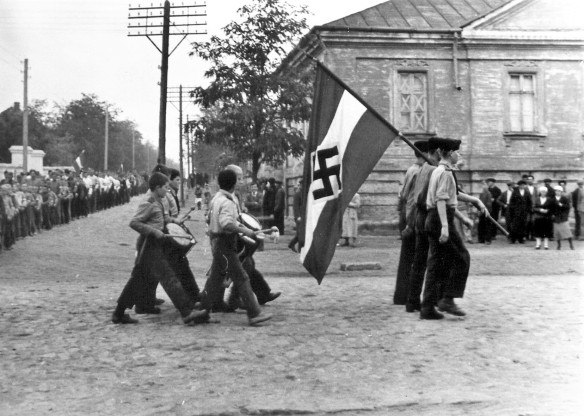A Chilling Tale: Mennonite History and the Holocaust

The Mennonite kindergarten in Einlage, southeastern Ukraine, was a Nazi showpiece. WWII Nazi occupiers had gone door-to-door, categorizing inhabitants according to “genealogical and racial biological” criteria. One hundred and twenty-nine of the 10,000 kindergarten children deemed to have “German blood” found themselves in this exclusive school.
At Christmas, soldiers handed out wooden toys. German carols, not sung openly since the Bolsheviks had seized power in 1917, rang through the hall. It was the first time many of the children had seen a Christmas tree.
My grandparents and two great-grandfathers had immigrated to Canada in the 1920s from this area of Ukraine, then part of Russia. Although they’d withstood atrocious times during the Bolshevik revolution and Civil War. However, worse times were ahead for many of their relatives. Those who survived the initial onslaught, faced further decades of terror, starvation, and deprivation under Joseph Stalin.
Journalists ascribed these terrors to ”Jewish-Bolshevik tyranny.” As Mennonites (and to a lesser extent, Lutherans and Catholics) were feted by the Nazis, Jewish property was seized and redistributed. Mennonites received “used clothing” through aid agencies such as the German Red Cross.
Individuals with the church participated in fascism and genocide. It was a chilling turn of events for a cultural group where nonresistance was a tenet of their faith; who were known as a peace church. They justified their position through stories that weren’t true.
Confronting darkness is hard to do when you’re already living in fear, hunger, and constant danger.
But how is it that even today, some Mennonites who grew up in Ukraine during this time express gratitude for their generous treatment by the Third Reich? Why are Nazi officials credited with returning a “semblance of normal life“ to Ukraine?
These stories of “rescue” are indelibly embedded into the collective psyche. They continue to operate from the subconscious of the survivors and descendants of that era.
I’ve never had to worry about a knock on our farmhouse door and hear my father taken away in the middle of the night. My plate and my closet have always been full. I’ve grown up in a land of opportunity and abundance. I can’t fathom life under a cruel totalitarian regime.
Yet, I, too, have grown up with stories that have shaped my world view and life choices. Stories are powerful and they stay with us, especially the stories we’re told as a child. Questioning them is what prompted me to set off on the quest narrated in Crash Landing.
We can’t alter the past, but we create the present and future. Let’s make sure we consider all sides before judging another. Practice curiosity rather than accepting a story at face value.
Change begins with us.
Resources:

Liz,
Thanks for the update. I haven’t started to read Crash Landing yet, but I’m looking forward to it.
Norm